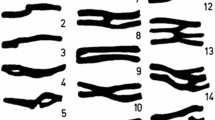Abstract
Purpose
Congenital tracheal stenosis is a disease in which complete tracheal cartilage rings (CTCR) cause airway narrowing. Although tracheal cartilage malformation has been suggested as a cause of CTCR, no histological studies have been performed. Here, we report a comparison of the tissues from CTCR and normal tracheal cartilage.
Methods
Thirty-one infants who underwent slide tracheoplasty at our institution from May 2016 to August 2019 were included. Tissues from ten autopsy cases without tracheal lesions were used as controls. The survey items were tracheal cartilage cell density, cartilage thickness, and chondrocyte findings.
Results
The median cartilage cell density from cases was 23/125 × 125 µm2 and from controls was 23.5/125 × 125 µm2 (p = 0.90). The median cartilage thickness from cases was 689 µm and from controls was 840 µm (p = 0.11). Comparing the ventral and dorsal sides of the CTCR tissues, the cell density was significantly different (median ventral 23/125 × 125 µm2; median dorsal 19.5/125 × 125 µm2; p = 0.034). There were no significant findings in the chondrocytes of the CTCR tissues.
Conclusion
CTCR tissues did not differ in cartilage density and thickness from normal tracheal cartilage.


Similar content being viewed by others
References
Maeda K (2017) Pediatric airway surgery. Pediatr Surg Int 33:435–443. https://doi.org/10.1007/s00383-016-4050-7
Chen JC, Holinger LD (1994) Congenital tracheal anomalies: pathology study using serial macrosections and review of the literature. Pediatr Pathol 14:513–537. https://doi.org/10.3109/15513819409024281
Faust RA, Stroh B, Rimell F (1998) The near complete tracheal ring deformity. Int J Pediatr Otorhinolaryngol 45:171–176. https://doi.org/10.1016/s0165-5876(98)00100-1
Sinner DI, Carey B, Zgherea D, Kaufman KM, Leesman L, Wood RE, Rutter MJ, de Alarcon A, Elluru RG, Harley JB, Whitsett JA (2019) Complete tracheal ring deformity: a translational genomics approach to pathogenesis. Am J Respir Crit Care Med 200:1267–1281. https://doi.org/10.1164/rccm.201809-1626oc
Morita K, Yokoi A, Fukuzawa H, Hisamatsu C, Endo K, Okata Y, Tamaki A, Mishima Y, Oshima Y, Maeda K (2016) Surgical intervention strategies for congenital tracheal stenosis associated with a tracheal bronchus based on the location of stenosis. Pediatr Surg Int 32:915–919. https://doi.org/10.1007/s00383-016-3928-8
Jefferson ND, Cohen AP, Rutter MJ (2016) Subglottic stenosis. Semin Pediatric Surg 25:138–143. https://doi.org/10.1053/j.sempedsurg.2016.02.006
Fraga JC, Gabra HOS, Calkoen EE, McLaren CA, Roebuck DJ, Elliott MJ (2009) Long segment congenital tracheal stenosis in twins successfully treated by slide tracheoplasty. J Pediatr Surg 44:640–643. https://doi.org/10.1016/j.jpedsurg.2008.10.105
Messineo A, Forte V, Joseph T, Silver MM, Filler RM (1992) The balloon posterior tracheal split: a technique for managing tracheal stenosis in the premature infant. J Pediatr Surg 27:1142–1144. https://doi.org/10.1016/0022-3468(92)90576-s
Bagwell CE, Talbert JL, Tepas JJ III (1991) Balloon dilatation of long-segment tracheal stenoses. J Pediatr Surg 26:153–159. https://doi.org/10.1016/0022-3468(91)90897-3
Acknowledgements
We are grateful to Dr. Makiko Yoshida of the Department of Pathology, Kobe Children’s Hospital, for advice and expertise.
Funding
This research received no specific grant from any funding agency in the public, commercial, or not-for-profit sectors.
Author information
Authors and Affiliations
Contributions
Conceptualization and methodology: HF, KM; formal analysis, investigation and writing: YF, KM; supervision: KM.
Corresponding author
Ethics declarations
Conflict of interest
The authors declare that they have no conflicts of interest.
Ethical approval
This study has been approved by the institutional ethics committee (approval number: R31-23) and performed in line with the principles of the Declaration of Helsinki.
Informed consent
Since this study was widely open to the public, guaranteed a refusal to cooperate, and the data was anonymous, separate informed consent was waived.
Additional information
Publisher's Note
Springer Nature remains neutral with regard to jurisdictional claims in published maps and institutional affiliations.
Rights and permissions
About this article
Cite this article
Fujieda, Y., Morita, K., Fukuzawa, H. et al. Histological features of complete tracheal rings in congenital tracheal stenosis. Pediatr Surg Int 37, 257–260 (2021). https://doi.org/10.1007/s00383-020-04803-z
Accepted:
Published:
Issue Date:
DOI: https://doi.org/10.1007/s00383-020-04803-z




